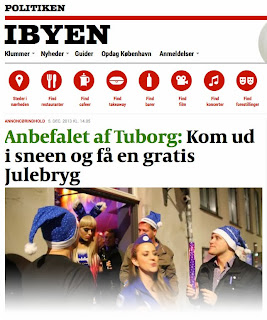”TO BE PLAYED AT MAXIMUM VOLUME”, stod der på bagsiden af David Bowies Ziggy Stardust-album. Tilsvarende burde Politiken måske forsyne sit nyligt redesignede website med instruktionen ”Bør kun ses i perfekt skærmkvalitet”. Undertegnede prøvede for eksperimentets skyld at læse Politiken.dk på mit lokale kommunebibliotek, og det var bestemt ingen visuel nydelse. Udstyret skal være tip-top, hvis ikke den ny rubrikskrifts sarte kurver skal forvandles til musetrapper.
Politikens overordnede designstrategi går ud på at strømline det formmæssige udtryk på tværs af platformene. Derfor har man slettet suffixen .dk, så sitet nu blot hedder POLITIKEN slet og ret; derfor har man droppet pastelfarverne, der skulle markere sitets forskellige sektioner, og destilleret paletten ind til sort, hvid og rød (samt en breaking news-gul); og derfor har man indført Capitolium News som universel rubrikskrift, ganske som i papiravisen.
En kort overgang var Capitolium også gjort til brødskrift, men det medførte så mange klager over læseligheden (først og fremmest fra pc-brugere, tænk at vi også har sådan nogle, kan man næsten høre dem måbe inde på Rådhuspladsen), at Georgia fik et lyncomeback i desktop-udgaven. Capitolium har derimod fået lov at beholde pladsen som brødskrift på mobilsitet, hvor den faktisk fungerer rigtig godt.
VISDOMMEN I AT KONSOLIDERE BRANDET på tværs af platformene synes indlysende, og her er typografien naturligvis et vigtigt redskab. Der er imidlertid himmelvid forskel på, hvordan den sirlige – i mine øjne temmelig impotente, men andre synes jo om den – antikvaskrift Capitolium News fremstår på papir, i et relativt roligt visuelt miljø omgivet af store grå tekstflader og masser af ”kreativ luft”, og på webforsidens virvar af annoncer, små billeder og korte henvisninger.
I desktop-udgaven er Politikens website således, indtil videre i hvert fald og stik imod hensigten, endt som lidt af et typografisk kludetæppe.
TIL GENGÆLD ER ARKITEKTUREN forenklet kraftigt. Navigationsbåndene er væk, bortset fra kundeservice i toppen, og afløst af to drop down-menuer med sektionsoversigten samt listen over de seneste nyheder. En logisk konsekvens af, at smartphones med ekspresfart er ved at overtage rollen som danskernes – og altså også Politiken-læsernes – foretrukne nyhedsplatform.
EN NY SEKTION med det forpligtende navn MAGASINET retter sig nok i højere grad mod tablet-brugerne. Her tilbydes ”langlæsning” – blandt andet artikler, der har været trykt i søndagsavisens PS-sektion – i en minimalistisk opsætning, som virker overbevisende ”politikensk” i sit udtryk. Også fordi avisen her får anledning til at eksponere sine dygtige fotografer, ligesom der gøres brug af det digitale formats muligheder for eksempelvis at inddrage videoklip.
Indtil videre er Magasinets artikelsider friholdt for annoncer; men lur mig, om ikke der ligger en plan i skuffen for, hvordan der kan kapitaliseres på dette spændende nye format, som er et lovende bud på, hvordan en stærk journalistisk tradition vil kunne transformeres til en papirløs fremtid.
MERE KONTROVERSIELT er det måske, at man også har indført såkaldt ”sponsoreret indhold” på sitet. Såsom en ”artikel” om julebryg – med Tuborg i bylinen. Denne relancering understreger således Politikens position i danske nyhedsmediers fortrop, hvad digital omstilling gælder. På godt og ondt.


































